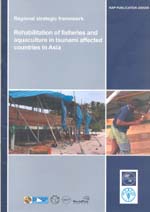
Regional strategic framework for rehabilitation of fisheries and aquaculture in tsunami affected countries in Asia
 |
RAP PUBLICATION 2005/09
Regional strategic framework for rehabilitation of fisheries and aquaculture in tsunami affected countries in Asia |
|
|
|
The designations employed and the presentation of material in this publication do not imply the expression of any opinion whatsoever on the part of the Food and Agriculture Organization of the United Nations, Bay of Bengal Programme-Inter-Governmental Organisation, Network of Aquaculture Centres in Asia-Pacific, Southeast Asian Fisheries Development Center and the WorldFish Center concerning the legal status of any country, territory, city or area or of its authorities, or concerning the delimitation of its frontiers or boundaries. All rights reserved. Reproduction and dissemination of material in this information product for educational or other non-commercial purposes are authorized without any prior written permission from the copyright holders provided the source is fully acknowledged. Reproduction of material in this information product for sale or other commercial purposes is prohibited without written permission of the copyright holders. Applications for such permission should be addressed to the Secretary, Asia-Pacific Fishery Commission, FAO Regional Office for Asia and the Pacific, Maliwan Mansion, 39 Phra Athit Road, Bangkok 10200, Thailand or by e-mail to [email protected]. |
© FAO 2005
The regional strategic framework presented here has been developed in support of recovery and rehabilitation efforts following the earthquake and subsequent tsunami waves that originated off the west coast of northern Sumatra on the 26 December 2004 and that caused extensive damage to coastal communities in the region. Estimates of the human cost are just under 300 000 killed (or still missing) with a negative impact on the livelihoods of around five million people. The total cost of recovery for the affected areas could be over $ 11.5 billion USD. Importantly, the majority of those affected in the coastal communities had livelihoods based on agriculture, aquaculture and fisheries, or were employed in associated enterprises. In response to the disaster, a consortium (CONSRN) of key regional agencies was formed with the objective of supporting coordination and harmonization of rehabilitation efforts in fisheries and aquaculture. In particular, it was agreed that activities were to focus on collating and disseminating information, carrying out assessments and supporting partners and governments to build a common vision for post-tsunami rehabilitation of the sector. A regional workshop on Rehabilitation of Fisheries and Aquaculture in Coastal Communities of tsunami affected countries in Asia (28th February-1st March 2005, Bangkok, Thailand) was held with the objective of defining and agreeing a joint vision, strategies and a set of guiding principles. The framework presented here consists of a vision for the rehabilitation of the fishery and aquaculture sectors which reflects an ideal state towards which all strategies and activities contribute and which avoids the mistakes of the past. Six strategic elements in support of this vision are described. These include support to: improving policy and institutions; providing appropriate physical assets; restoring the environment (while ensuring equitable access); providing appropriate financial support; improving capacity in support of community livelihoods, responsible coastal resource management and the rebuilding of social assets. The framework outline the rationale for these strategic elements and describes potential activities and outputs in support of them. A series of agreed guiding principles are outlined which are intended to guide the rehabilitation and development activities described in the framework. The framework outlines the basis for action by the consortium and partners. In order to support further action, a provisional implementation strategy for activities in its support has also been developed. The key elements of this include: collaboration in conducting needs assessments, development of agreed rehabilitation plans, working together to mobilize resources for rehabilitation and implementation of these plans through projects and programmes either independently as members or jointly as a consortium. While this regional strategic framework has been developed from the output of a consortium workshop it is intended to support not just the work of the partners but also to guide and inform other agencies involved in the broader tsunami rehabilitation and development work.
He Changchui
Assistant Director-General and
FAO Regional Representative for Asia and the Pacific
1. The purpose of the regional strategic framework
2. The regional strategic framework
3. Strategic elements in support of the regional framework for fisheries and aquaculture
Strategic element 1. Improve policy, institutions and processes
Strategic element 2. Provide appropriate physical assets
Strategic element 3. Restore the natural environment
Strategic element 4. Provide appropriate financial mechanisms
4. Implementation of the regional strategic framework
APPENDIX A. Guiding principles for rehabilitation and development